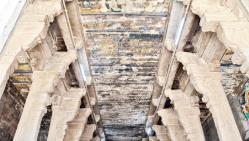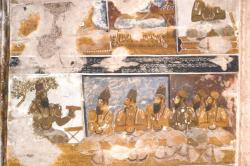INSTITUT SUPERIEUR D'ANTHROPOLOGIE
INSTITUTE OF ANTHROPOLOGY
ONLINE COURSES / COURS A DISTANCE
FALL TERM : OCTOBER 2016
REGISTER NOW
INDE – 
 Srirangam - Srirangam Sri Ranganathaswamy Temple has a special place in the Vaishnavite tradition and beliefs. Over the centuries, several dynasties have enriched the heritage of Srirangam temple by contributing in the form of art on temple ceilings and walls. Around 50 per cent of the 400-year-old murals, believed to have beeen painted during the period of Nayaka rulers of the Vijayanagar Empire, have already faded away The work around the sanctorum of Ranganayaki shrine, likely to have been painted during the reign of Vijayanagar Empire, can be spotted on the ceilings and as well as the left walls of Serthi, Vasantha and Oonjal Mandapams. According to H Sudarshan, a representative of Tamil Nadu Heritage Forum in Srirangam, the murals depict the Bhagavatham, one of the 18 greatest Hindu texts, and deal with various Vaishnavite beliefs, including incarnations of Lord Vishnu. Besides the literature, even the daily rituals of the temple and the grand receptions given to Vijayanagara kings and the Nayaks have been painted as murals using natural dyes. However, lack of maintenance over the years have distorted half the murals, including the ones on Gajendra Moksha and Churning of the Ocean of Milk for elixir.
Srirangam - Srirangam Sri Ranganathaswamy Temple has a special place in the Vaishnavite tradition and beliefs. Over the centuries, several dynasties have enriched the heritage of Srirangam temple by contributing in the form of art on temple ceilings and walls. Around 50 per cent of the 400-year-old murals, believed to have beeen painted during the period of Nayaka rulers of the Vijayanagar Empire, have already faded away The work around the sanctorum of Ranganayaki shrine, likely to have been painted during the reign of Vijayanagar Empire, can be spotted on the ceilings and as well as the left walls of Serthi, Vasantha and Oonjal Mandapams. According to H Sudarshan, a representative of Tamil Nadu Heritage Forum in Srirangam, the murals depict the Bhagavatham, one of the 18 greatest Hindu texts, and deal with various Vaishnavite beliefs, including incarnations of Lord Vishnu. Besides the literature, even the daily rituals of the temple and the grand receptions given to Vijayanagara kings and the Nayaks have been painted as murals using natural dyes. However, lack of maintenance over the years have distorted half the murals, including the ones on Gajendra Moksha and Churning of the Ocean of Milk for elixir.
http://www.newindianexpress.com/states/tamil_nadu/Fading-murals-of-Srirangam-tell-a-tale-of-apathy/2016/07/11/article3523189.ece
INDE - Lakhamandal - The ancient site of Lakhamandal, known for its connection with the Pandavas who are believed to have stayed here during their exile, is teeming with old idols and artefacts mainly dating from the fifth to 12th centuries. However, most are still buried underground and Archaeological Survey of India (ASI) officials say they have neither the resources nor the manpower for excavations. The temple complex in the Jaunsar-Bawar region is 35 km from Chakrata on the Mussoorie-Yamunotri Road, and nearly 128 km from the state capital. In 2003, eight idols were stolen from the ancient Shiva temple here, which follows the unique tradition of devotees offering shivlings to the deity, resulting in hundreds of shivlings at the temple now. Seven of the eight stolen idols were recovered in 2004, but have been lying at ASI's Dehradun office ever since. Babu Ram, member of the Lakhamandal temple committee said that "many idols and artefacts are lying buried in the ground, and the palace of lac where the Pandavas are believed to have lived, has also been buried under a landslide. These must be excavated."
http://timesofindia.indiatimes.com/city/dehradun/Ancient-archaeological-goldmine-near-Dehradun-untapped-ASI-says-no-funds-to-excavate/articleshow/53143322.cms
TURQUIE –  Şanlıurfa - A large number of expansive rock tombs which could constitute part of the world’s largest necropolis have been discovered during work carried out by the Şanlıurfa Municipality around the historic Urfa Castle in southeastern Turkey. Within the scope of the works carried out by archaeologists on the area of some 45,000 square meters, nearly 80 tombs have been restored so far, while roads have been built and environmental arrangements have been made in the area. These restorations were important steps to help turn the southeastern province into a center of attraction. Among the newly found tombs, one was situated on the highest part of the castle’s hill and was bigger than the other tombs. It was estimated to have belonged to the nobles of Edessa King Abgar’s family. The tomb had rooms for 10 people. Also, floor mosaics were found in one of the tombs. Syriac inscriptions and fine engravings can also be seen in another tomb in the area. Officials said the area could be the world’s largest necropolis when the other rock tombs in the skirts of the castle, in the Kızılkoyun and Dedeosman neighborhoods, were fully uncovered.
Şanlıurfa - A large number of expansive rock tombs which could constitute part of the world’s largest necropolis have been discovered during work carried out by the Şanlıurfa Municipality around the historic Urfa Castle in southeastern Turkey. Within the scope of the works carried out by archaeologists on the area of some 45,000 square meters, nearly 80 tombs have been restored so far, while roads have been built and environmental arrangements have been made in the area. These restorations were important steps to help turn the southeastern province into a center of attraction. Among the newly found tombs, one was situated on the highest part of the castle’s hill and was bigger than the other tombs. It was estimated to have belonged to the nobles of Edessa King Abgar’s family. The tomb had rooms for 10 people. Also, floor mosaics were found in one of the tombs. Syriac inscriptions and fine engravings can also be seen in another tomb in the area. Officials said the area could be the world’s largest necropolis when the other rock tombs in the skirts of the castle, in the Kızılkoyun and Dedeosman neighborhoods, were fully uncovered.
http://www.hurriyetdailynews.com/worlds-largest-necropolis-in-turkeys-southeast.aspx?pageID=238&nid=101419
INDE –  Motupalli - Two stone idols of Buddha have been found in the debris of a Veerabhadra Swamy temple tank at Motupalli village in Prakasam district. The idols date back to 9th-10th centuries AD. Assisted by Govind, sarpanch of Rudramambapuram, a hamlet in Motupalli, a local resident Dhararatha Reddy Raju and Tenali-based amateur archaeologist K. Venkateswara Rao, Mr. Nagireddy pored over the area and identified a few pot shreds, Chinese enamel ware and fragments of shell bangles, all dated to the Chola period. In the vicinity, a huge red colour earthenware (a jar) and three terracotta rings with a din of 4-0 ft and 1-ft-high also dating back to the Chola era were found. The left palm of the Buddha idol has a motif of a Dharmachakra, similar to an idol found in Amaravati earlier, also belonging to the 9th -10th centuries AD. Another Buddha idol carved in black basalt stone was also found in the debris. Mr. Nagireddy said the articles discovered were of great historic significance. He said that excavations taken up by the Department of Archaeology in the 1970s yielded Chinese ware and copper coins of the Ming dynasty, coins belonging to the Chola era and bronze articles and pottery at the port area confirming that Motupalli had served as an international port town during the medieval period.
Motupalli - Two stone idols of Buddha have been found in the debris of a Veerabhadra Swamy temple tank at Motupalli village in Prakasam district. The idols date back to 9th-10th centuries AD. Assisted by Govind, sarpanch of Rudramambapuram, a hamlet in Motupalli, a local resident Dhararatha Reddy Raju and Tenali-based amateur archaeologist K. Venkateswara Rao, Mr. Nagireddy pored over the area and identified a few pot shreds, Chinese enamel ware and fragments of shell bangles, all dated to the Chola period. In the vicinity, a huge red colour earthenware (a jar) and three terracotta rings with a din of 4-0 ft and 1-ft-high also dating back to the Chola era were found. The left palm of the Buddha idol has a motif of a Dharmachakra, similar to an idol found in Amaravati earlier, also belonging to the 9th -10th centuries AD. Another Buddha idol carved in black basalt stone was also found in the debris. Mr. Nagireddy said the articles discovered were of great historic significance. He said that excavations taken up by the Department of Archaeology in the 1970s yielded Chinese ware and copper coins of the Ming dynasty, coins belonging to the Chola era and bronze articles and pottery at the port area confirming that Motupalli had served as an international port town during the medieval period.
http://www.thehindu.com/todays-paper/tp-national/tp-andhrapradesh/buddha-idols-found-in-temple-tank-debris/article8830033.ece